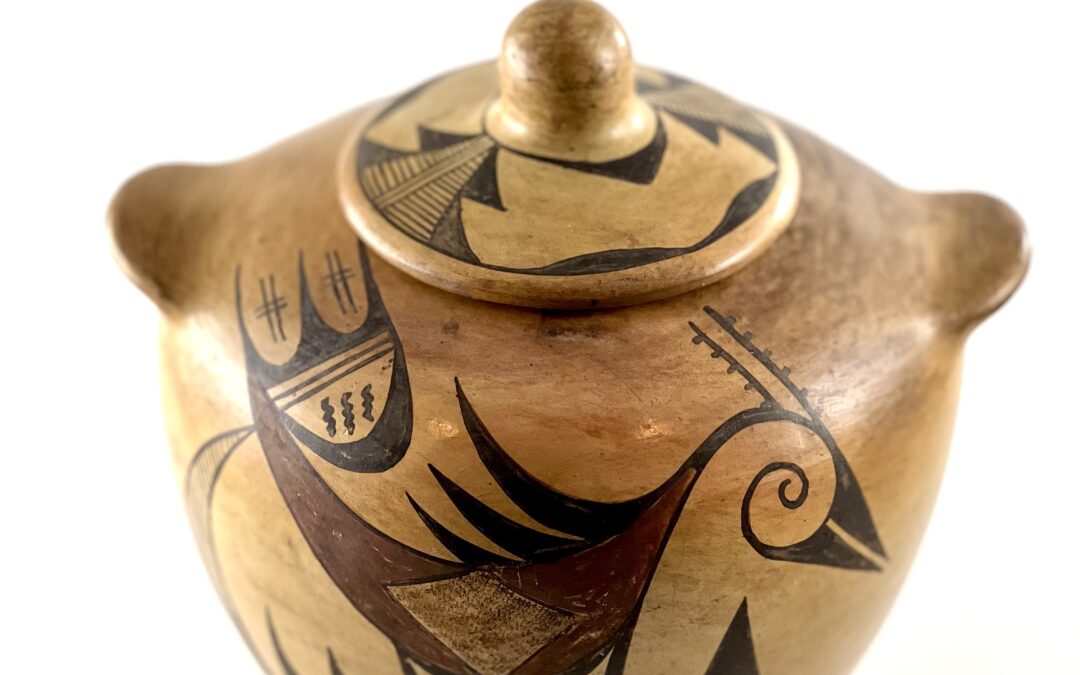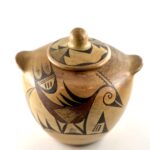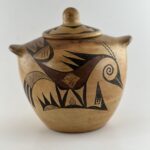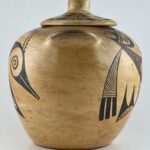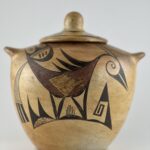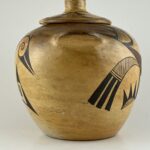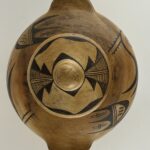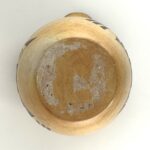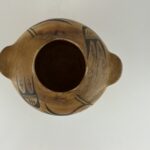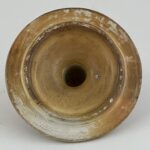Jar is 6.5625” h X 7.5625” wide without lid or handles. The lid is 2.1875” high and 4.25″ wide with a 3.1875” interior ring.
Since as early as 1300 CE, when coal-fired Jeddito ware was widely traded, potters at Hopi have been good at marketing. After Thomas Keam established a trading post near Hopi in 1873, pottery from Hopi was increasingly made for a commercial market since store-bought metal containers proved more durable than Hopi clay, though some “utility ware” continues to be made for indigenous use.
Potters from the mesas are always alert to trends that attract non-Native buyers and from the mid 1950’s to the late 1960’s found that there was a market for handled pots with wide mouths and lids that were sold and bought as cookie jars: tourist utility ware. That is the form of jar 2023-10.
Abstract, silly and perky: the birds that decorate this jar exude energy. The design is an exemplary display of Hopi folk art, a tradition that has almost disappeared over the last 40 years as pottery from Hopi developed from craft to fine art, with modern pots costing sometimes thousands of dollars and buyers expecting perfection. Folk art makes me smile; the design on this cookie jar expands that smile to a grin.
Form:
The 4.25-inch wide flat base of the jar is quite thick, smooth on the exterior but somewhat lumpy on the interior. From its base the jar expands gently outward to its maximum 7.5625-inch wide waist. At this point the jar has attained 83% of its height and then slopes gently inward to its 3.5-inch mouth, wide enough to fit a hand into to grab a cookie. Two 0.65625-inch solid lug handles are affixed to the jar at its waist. The walls of the jar are of even thickness and are substantial, as is appropriate for a jar intended to be used.
The form of the lid is quite complex. From the outside the lid seems simple: a gently upward sloping surface surmounted by a 1.25-inch knob. The underside revels the complexity. The knob is not a lump of clay stuck on the top but is hollow with smooth interior walls. The flange incorporates a 3.1875-inch ring that fits inside the jar’s mouth and keeps the top from sliding off the jar.
Please see “Appendix A” for a history of the commercialization of Hopi pottery and see “Utility Ware” in the “Category” listing for examples utility pottery from Hopi.
Design:
Except for minor variations, the bird designs on opposite sides of the jar are identical. The central body of each bird is boat-shaped and painted a dark maroon. All other design elements on the jar are black. At the center of the body is a black-bordered diamond stippled so lightly that the black paint appears brown. Off the right point of the body is a thin neck which evolves into a 1.5-inch diameter curlicue that would be 5-inches long if uncurled. This curlicue forms the face of the bird, with the tight final curl substituting for the eye. Off the right edge of the face is a large beak formed from two solid right triangles, slightly separated by an unpainted space. Sloping backward from the forehead are two straight-line antennas edged with 5 to 8 dots. Jutting upward from the neck is a saw-toothed element with three points, like a mane, if birds had manes. Reciprocal unpainted surface separates the three points, creating foreground/background reversal.
Off the left point of the body is a large bullet-shaped form, its leading right edge a thick U. Three parallel lines connect its points, a two-lane “highway.” The space between the U and the highway is unpainted except for three squiggly lines, thinly-drawn in one rendition and more thickly drawn on the second bird. Based on the back edge of the two-lane highway is a thick element with three points, like an oversized “w.” On either side of the central point are a a pair of short parallel lines crossed at their center by a pair of shorter parallel lines.
From the lower rear edge of the bird emerges a curved fan-shaped element, its first 2.5-inches filled with 26 to 30 parallel lines. This section ends with another two-lane highway followed by three 1.5-long feathers with squared tips.
The birds are standing on two legs in an abstracted landscaped. Each leg is composed of two long, curved, blades forming a large “V,” point downward. The ground below the head has a very short and wide hill that merges with a large right triangle. Off the upper point of this first triangle is an isosceles triangle oriented so that the right edges of the two triangles together form the edge of a larger isosceles triangle. However the lower left side of this larger triangle is missing so that the top triangle is left hanging over a void. Descending from the left edge of the top triangle into this void is a squared off greek key with 4 turns. On the ground between the legs is a short and wide hill with six vertical lines emerging from its apex, the central pair taller than the flanking pairs. Below the tail is a wide and fairly tall stippled hill toped by two large tooth-like elements, again forming foreground/background reversal with the surrounding unpainted surfaces.
The lid of this cookie jar displays a complex geometric design. A small circle surrounds the knob and a larger circle is drawn near the rim of the lid. The space between carries the design. The circle around the knob expands on opposite sides to form triangles. Off the other two sides of this small circle are complex elements, their center fan-shaped and looking a bit like Christmas trees. From their point to their base run three parallel lines, a “two-lane highway.” On either side of this highway the remaining space in the fan is filled with parallel lines. One fan has 16 parallel lines on both sides of its highway; the second rendition has 16 lines on one side and 14 on the other. While not precisely drawn, none of these 62 lines touches its neighbor. Projecting from the linear walls of the two fans are triangular elements that reemphasize a sense that the design was inspired by Christmas trees. Along the rim of the lid between the two fan-shaped designs are two conjoint low hills. The residual unpainted surface of the lid is curved and undulating along its outer edge with a pointed inner edge.
Design Analysis:
The even walls of the jar are indications of an experienced potter. The added lugs and complex form of the lid suggest a potter of exceptional skill and a willingness to add detailed features to this form that would increase its utility.
On the design the mass of the head and tail are about equal, so the bird appears balanced in spite of the large black beak. The large U-curve of the tail is visually balanced by the large curlicue of the head. The dome of the design at the tail and its pointed rear incorporating thin, parallel lines gives the overall impression of a rocket thrusting to the right. This thrust complements the forward thrusting energy of the pointed mane and forward-pointing beak, but this motion is counterbalanced by the circular curlicue of the face. The legs of the birds form a “W” that reflects the “W” pattern in the tail, thus helping integrate the design.
The design on the jar displays 11 sharply-pointed elements. The “Christmas tree” fan-shaped design on the lid incorporates four pointed elements, thus visually linking the jar and its lid.
Foreground/background reversal of the bird’s “mane” energizes the design. There is a similar effect on the lid where the unpainted surface has both an undulating and pointed shape that contrasts with the neighboring linear designs and has considerable eye appeal.
The 26 to 30 lines emerging from the fan at the rear of the bird are not evenly spaced, but they are carefully-drawn so that none of the lines touch. This pattern is evidence that the artist was both skilled and deliberate but not concerned with exactness. When this attitude is combined with the silly, delightful birds seen on jar 2023-10, the result is the very definition of folk art, of which this pot is a marvelous example.

